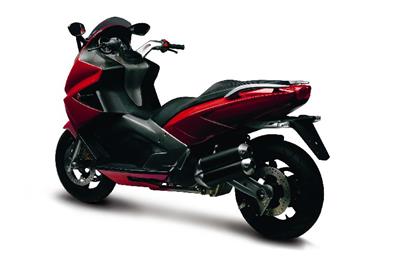A vision of your motorcycling future
It’s a shame the word ‘scooter’ got applied to little runabouts, because it’s become a term of denigration when any bike begins to show scooter-like qualities. Yet scooter-bikes or bike-scooters are on the way. And the process looks inevitable.
Let’s start at the front with this future machine. The wheels won’t go much below 16″, to give a good footprint, and get some decent discs in the wheels. Some GP bikes have run 16″ wheels for the quick steering they give.
Tyre sections will be very bike-like, 120 at the front, 180-ish at the rear.
Sticky rubber available to those who need it.
Engines may be as much as 1,000cc but more likely 750 or 800 in keeping with the current trend to down-size. Parallel twins will be the layout of choice for their compactness. V-twins are too bulky, despite the new Gilera 850 V-twin. The cost and complexity of fours isn’t needed because the auto transmission smoothes out the firing pulses of a twin. Engines will be water-cooled with fuel injection. They will be fixed in the chassis and won’t pivot with the rear wheel.
Automatic bikes have had a bad press. This was to do with the type of transmission fitted. They were torque converters, like car transmissions, that stirred gears in a conventional oil-filled box. There was no direct engine to wheel connection, and the losses in efficiency and fuel consumption were high. Costly to make too.
The modern CVT or Continuously Variable Transmission is much more efficient.
There is a dry centrifugal clutch with no drag losses from turning gears in an oil bath. The box is always in the right gear for what you’re doing, and because the ratio changes are seamless, there are no dodgy lurches from bad gearchanges when you’re cranked over. If you’ve ridden one of the bigger scoots, and nailed it at the lights, the stomp off the line is very impressive. Leaves most things for dead. Manual bikes of the same capacity and power need to be ridden pretty hard to keep up. And it’s hard work.
Manual bikers in the cities do an average of 300 clutch operations per mile.
A bar-mounted switch will allow three or four settings for the type of riding you want to do.
How long do the drive belts last? The book says change at 15,000 miles but they’ll do 20,000 easy. They’re cheaper than chains, need no lubrication and are silent running. The GP teams say chain drives on their bikes costs them
3 bhp.
The rear suspensions will follow current bike practice, with good adjustability front and back. Linked brakes are likely, with ABS becoming standard. As these scooter-bikes become more bike-like, with very similar performance, their handling and road holding will have to match. As bikes become more scooter-like, we’ll see on-board stowage for a lid and other kit. Fuel range should grow to the level where touring is entirely practical. Adjustable screens will be common, with decent wind-carving fairings. As these scooter-bikes can easily do over 100 mph there’s as much need to streamline them as a modern sports bike. Lights and indicators to taste, but usually faired into the mirrors and rear bodywork.
The ultimate test? Take one on a track day and nail it everywhere you can.
The surprised looks on the faces will be worth a guinea a minute. OK, so the brain-dead sports bike loonies will do better times, but by how much? Yet it’s the everyday practicality of the bike-scoots which will win people over. They’ll do everything well. And for most folks the reality is the need to keep putting in good point-to-point times over runs you know, and to do it in comfort and with good economy. Want to know the best part? When you’re riding an auto you’re a better biker because you’re safer, and you get to enjoy the countryside more because you’re not wrestling with the hassle of multi-task bike management.


